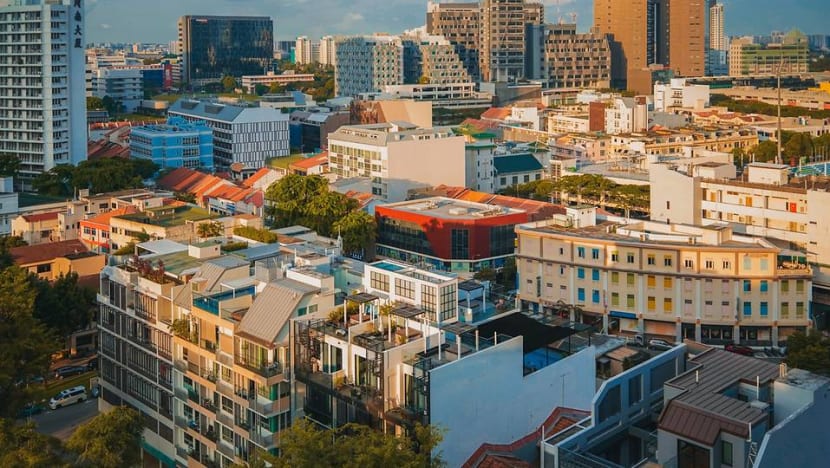IRAS to claw back S$60 million from private property buyers who used '99-to-1' scheme to reduce ABSD
"The '99-to-1' arrangement is a tax avoidance arrangement used by some property buyers to reduce the rightful Additional Buyer’s Stamp Duty payable on the purchase of a residential property," says Deputy Prime Minister Lawrence Wong.

Private apartments in Farrer Park in Singapore. (Photo: Unsplash/Eugenia Clara)

This audio is generated by an AI tool.
SINGAPORE: The Inland Revenue Authority of Singapore (IRAS) has found 166 cases of private property purchases involving the “99-to-1” scheme as a means to avoid paying the additional buyer’s stamp duty (ABSD).
Mr Chee Hong Tat, who was then Senior Minister of State for Finance, said in April last year that as part of its surveillance efforts, IRAS had detected a small but rising number of “99-to-1” arrangements in recent years and the authority had initiated audits of such transactions.
IRAS, as of April, has completed the review of 187 such “99-to-1” cases, of which 166 cases were found to have involved tax avoidance, said Deputy Prime Minister and Minister for Finance Lawrence Wong on Tuesday (May 7).
"About S$60 million (US$44 million) in ABSD and surcharges will accordingly be clawed back," he added.
Mr Wong was responding to Ms He Ting Ru's (WP-Sengkang) parliamentary questions about the "99-to-1" scheme.
She had asked about how many referrals had IRAS made to the Council for Estate Agencies and the Law Society in the course of its investigations, whether there were any findings to be shared on their results and if the government would look to assist private property buyers who have been "misadvised" by estate agents and lawyers to obtain compensation.
On the "99-to-1" arrangement, Mr Wong said it is a "tax avoidance arrangement used by some property buyers to reduce the rightful ABSD payable on the purchase of a residential property".
What is ABSD and how does the "99-to-1" scheme work?
The government introduced ABSD as a tax in 2011 to manage demand for property. From Apr 27, 2023, Singaporeans must pay 20 per cent in ABSD, up from 17 per cent, when purchasing a second property, and 30 per cent on subsequent purchases.
Those figures are higher for permanent residents and foreigners.
ABSD is computed "on the purchase price as stated in the dutiable document or the market value of the property", whichever is the higher amount, according to the Inland Revenue Authority of Singapore (IRAS) website.
There are two ways to buy property in Singapore when there are two owners: One would be joint tenancy, which is commonly used by couples, where both parties will have an equal share of the property.
The second way would be tenancy-in-common, which is commonly used for investment properties. Under this structure, the co-owners own a specific number of shares in the property and this could be split in any ratio, such as 80 to 20.
IRAS is looking into the second way – private property buyers who have entered into split agreements with the possible intention of avoiding ABSD.
If the 99-to-1 intention is declared at the outset, the ABSD is payable as long as one party is an existing property owner.
What IRAS is looking out for are cases of possible tax avoidance by buyers who have entered into a 99-to-1 scheme in which the 1 per cent stake is sold immediately after the purchase option is exercised.
Using such an arrangement, where the 1 per cent stake is sold in the second stage, as an example:
A Singaporean who owns a residential property buys a second. This means he is liable to pay ABSD of 20 per cent.
If the property costs S$1 million (US$752,000) and he buys 1 per cent of this, his share of the property is S$10,000. Therefore, he has to pay 20 per cent of S$10,000 – that is, S$2,000 – as ABSD.
When a residential property is jointly purchased by two or more buyers, the ABSD rate arising from the buyer with the highest ABSD profile will apply on the entire value of the purchase.
Hence, when a single purchase is split up into two or more steps to reduce the tax payable, the Commissioner of Stamp Duties is empowered under Section 33A of the Stamp Duties Act to disregard the individual steps and assess stamp duty as a single joint purchase, and to recover the rightful amount of ABSD due.
10 CASES UNDER REVIEW BY COUNCIL FOR ESTATE AGENCIES
He explained that when such arrangements are made to reduce the tax payable, the Commissioner of Stamp Duties is empowered to "disregard the individual transactions and assess them as a single joint purchase".
Mr Wong added that the commissioner is also empowered to recover the rightful amount of ABSD due, along with a 50 per cent surcharge.
Of the 166 cases found to have involved tax avoidance, about 10 of them have evidence of potential involvement by property agents and are "currently under review by the Council for Estate Agencies (CEA)".
Such audits are part of regular checks by Singapore's tax authority to uncover "contrived or artificial" setups that home buyers use to avoid paying tax or stamp duties.
IRAS told CNA last April that if it determines that tax avoidance has taken place, it will recover the rightful amount of stamp duty and impose a 50 per cent surcharge on the additional duty payable.
If the stamp duty and surcharge are not paid by the deadline, it can also impose penalties of up to four times the outstanding amount.
IRAS added that the time frame does not matter and that audits can be conducted on any past cases or transactions.
Mr Chee said in parliament last April that from 2018 to 2021, about 0.5 per cent of private residential properties transacted involved “99-to-1” or similar arrangements, and action will be taken against both buyers and property agents.
In the case of property agents, IRAS will refer them to CEA for investigation and disciplinary action.
"Depending on the severity of the breach, agents may face financial penalties and/or suspension of their registrations," Mr Chee then said.
IRAS will also refer individuals who promote or facilitate such tax avoidance arrangements to the relevant regulatory agencies, he added.
In response to queries from CNA, CEA said on Friday that it "takes a serious view of property agents who do not act responsibly and professionally".
"Under the Council for Estate Agencies Code of Ethics and Professional Client Care, property agencies and their agents are required to conduct estate agency work with due diligence and care, and in compliance with all laws including statutory and regulatory requirements," a CEA spokesperson said.
"They must act ethically and honestly, and should not collaborate with or induce the client or any other person to engage in illegal, dishonest or unethical practices."
The spokesperson added: "We will take appropriate enforcement action against any property agencies or agents who breach the Code of Ethics and Professional Client Care when conducting estate agency work for their clients."
Serious code breaches could result in disciplinary action from CEA's Disciplinary Committee, with errant property agencies facing financial penalties of up to S$200,000, the revocation or suspension of their licences, or both.
Property agents referred to the Disciplinary Committee, meanwhile, could face penalties of up to S$100,000, the revocation or suspension of their registrations, or both.
Minor code breaches can result in agencies and agents being censured, handed financial penalties of up to S$5,000, or both.
The spokesperson declined to comment on the cases that have been referred to CEA as they are currently under investigation, but said: "No agents have been investigated for their involvement in similar cases before."

















